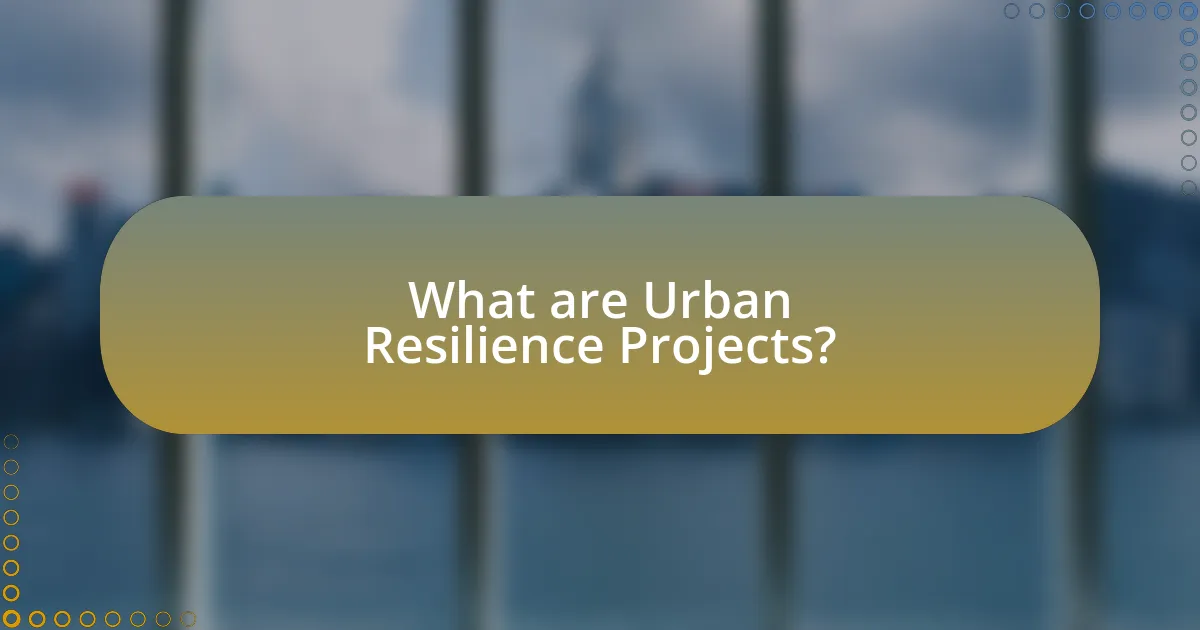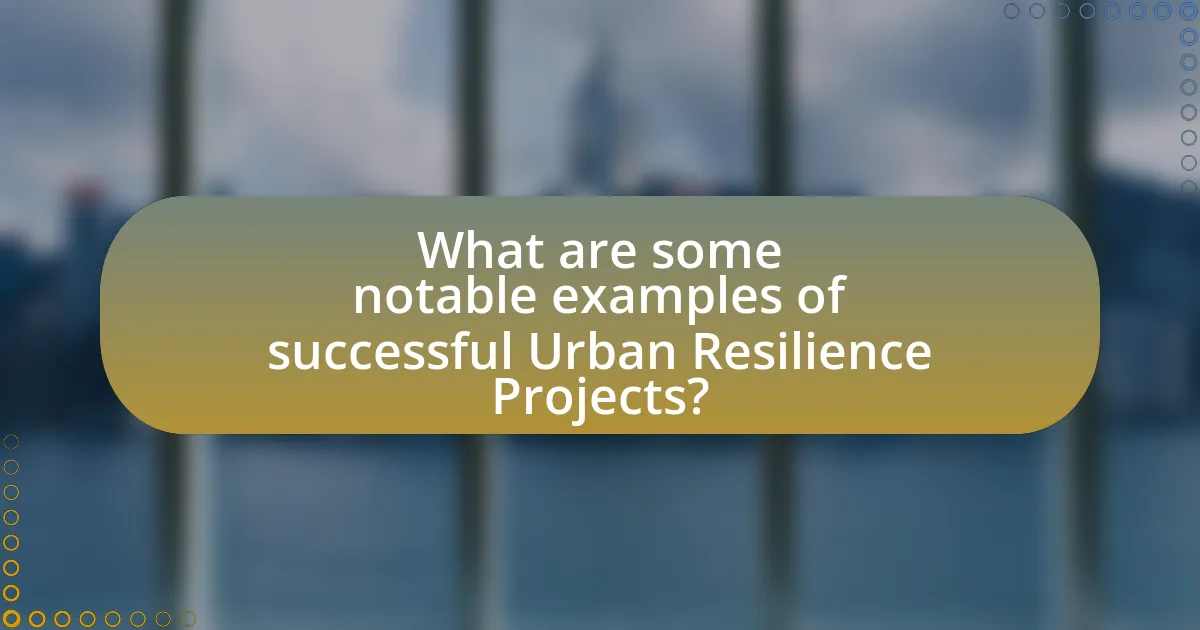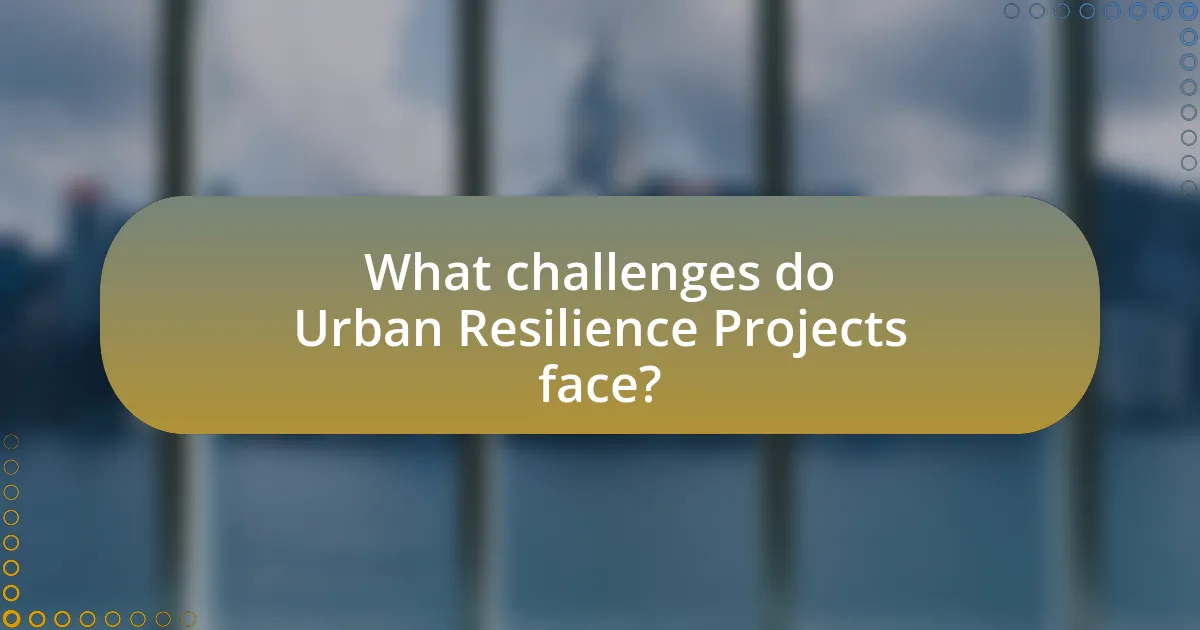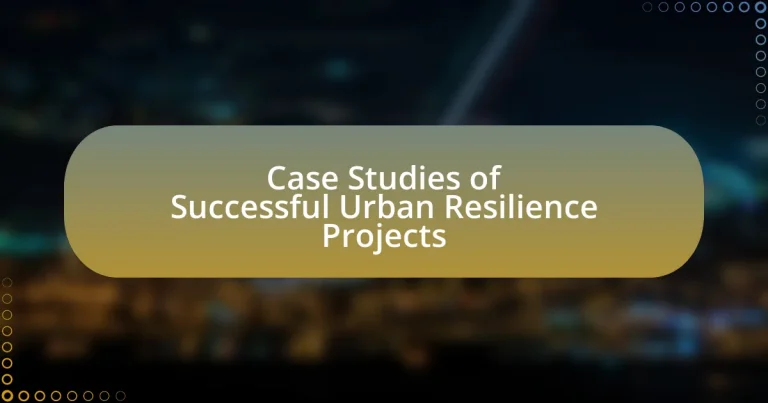Urban resilience projects are initiatives aimed at enhancing the capacity of urban areas to withstand and recover from challenges such as climate change and socio-economic stresses. This article examines successful case studies of urban resilience projects, highlighting their contributions to city sustainability, key characteristics, and the role of community engagement. Notable examples include the Rotterdam Climate Initiative and New York City’s post-Hurricane Sandy recovery efforts, which demonstrate effective strategies for improving infrastructure and fostering community involvement. The article also addresses the challenges these projects face, such as funding limitations and the importance of data availability, while outlining best practices for future resilience initiatives.

What are Urban Resilience Projects?
Urban resilience projects are initiatives designed to enhance the ability of urban areas to withstand, adapt to, and recover from various challenges, including climate change, natural disasters, and socio-economic stresses. These projects often involve infrastructure improvements, community engagement, and sustainable practices aimed at reducing vulnerability and increasing adaptive capacity. For instance, the 2015 report by the United Nations Office for Disaster Risk Reduction highlights that cities implementing resilience strategies can significantly lower disaster-related losses, demonstrating the effectiveness of such projects in real-world scenarios.
How do Urban Resilience Projects contribute to city sustainability?
Urban resilience projects enhance city sustainability by integrating adaptive strategies that mitigate environmental risks and promote resource efficiency. These projects often focus on improving infrastructure, such as green roofs and permeable pavements, which reduce urban heat and manage stormwater effectively. For instance, the implementation of green infrastructure in cities like Philadelphia has led to a 20% reduction in stormwater runoff, demonstrating a direct link between resilience initiatives and sustainable urban management. Additionally, urban resilience projects foster community engagement and social equity, ensuring that vulnerable populations are included in sustainability efforts, which is crucial for long-term urban viability.
What are the key characteristics of successful Urban Resilience Projects?
Successful Urban Resilience Projects are characterized by their adaptability, stakeholder engagement, and integration of sustainable practices. Adaptability allows these projects to respond effectively to changing environmental conditions and urban challenges, as seen in the Rotterdam Climate Initiative, which incorporates flexible infrastructure to manage flooding. Stakeholder engagement ensures that the needs and perspectives of local communities are considered, exemplified by the participatory approach in the New York City Resiliency Plan, which involved extensive public consultation. Lastly, the integration of sustainable practices, such as green infrastructure and renewable energy, is crucial; for instance, the implementation of green roofs in Chicago has demonstrated significant benefits in reducing urban heat and managing stormwater. These characteristics collectively enhance the resilience of urban areas against climate change and other disruptions.
How do these projects address climate change impacts?
These projects address climate change impacts by implementing adaptive strategies that enhance urban resilience. For instance, they often incorporate green infrastructure, such as urban forests and green roofs, which help mitigate heat island effects and manage stormwater, thereby reducing flooding risks. Evidence from cities like New York shows that green roofs can lower building energy use by up to 10% and significantly decrease runoff during heavy rainfall events. Additionally, these projects frequently involve community engagement and education, fostering local stewardship and awareness of climate issues, which is crucial for long-term sustainability.
Why are case studies important for understanding Urban Resilience?
Case studies are important for understanding urban resilience because they provide real-world examples of how cities adapt to challenges such as climate change, economic shifts, and social inequalities. By analyzing specific instances of urban resilience, researchers and policymakers can identify effective strategies, assess outcomes, and learn from both successes and failures. For example, the case study of New York City’s post-Hurricane Sandy recovery illustrates how infrastructure improvements and community engagement can enhance resilience. This evidence-based approach allows for the development of tailored solutions that can be applied in different urban contexts, ultimately contributing to more resilient cities.
What insights can be gained from analyzing successful case studies?
Analyzing successful case studies provides insights into effective strategies, best practices, and lessons learned that can be applied to similar contexts. These case studies often reveal the critical factors contributing to success, such as stakeholder engagement, innovative solutions, and adaptive management approaches. For instance, the case study of the Rotterdam Climate Initiative demonstrates how integrated urban planning and community involvement can enhance resilience against climate change impacts. This specific example illustrates that collaboration among various sectors leads to more sustainable outcomes, reinforcing the importance of a multi-faceted approach in urban resilience projects.
How do case studies inform future Urban Resilience strategies?
Case studies inform future Urban Resilience strategies by providing empirical evidence of successful interventions and their outcomes. These documented experiences allow urban planners and policymakers to analyze what worked, what did not, and the contextual factors influencing these results. For instance, the case study of New York City’s post-Hurricane Sandy recovery highlights the importance of integrating green infrastructure to manage stormwater, demonstrating that such strategies can reduce flooding risks and enhance community resilience. By examining specific metrics, such as the reduction in flood damage costs and improved public health outcomes, case studies serve as a valuable resource for developing data-driven, context-specific resilience strategies in urban environments.

What are some notable examples of successful Urban Resilience Projects?
Notable examples of successful Urban Resilience Projects include the Rotterdam Climate Initiative in the Netherlands, which aims to reduce greenhouse gas emissions by 50% by 2025 while enhancing the city’s climate adaptation strategies. Another example is the 100 Resilient Cities initiative, launched by the Rockefeller Foundation, which supports cities worldwide in developing resilience strategies to address physical, social, and economic challenges. Additionally, the New York City Resiliency Program focuses on infrastructure improvements and community engagement to prepare for future climate impacts, particularly following Hurricane Sandy. These projects demonstrate effective planning and implementation of resilience strategies in urban environments.
How did New York City enhance its resilience post-Hurricane Sandy?
New York City enhanced its resilience post-Hurricane Sandy by implementing the “OneNYC” initiative, which focuses on climate adaptation and infrastructure improvements. This initiative includes the construction of storm surge barriers, the elevation of critical infrastructure, and the restoration of natural ecosystems such as wetlands to absorb floodwaters. Additionally, the city invested approximately $19 billion in resilience projects, including the development of the East Side Coastal Resiliency Project, which aims to protect vulnerable neighborhoods from future flooding. These measures are supported by data indicating that areas with improved infrastructure and natural barriers significantly reduce flood risk, thereby validating the effectiveness of New York City’s resilience strategies.
What specific initiatives were implemented in New York City?
New York City implemented several specific initiatives aimed at enhancing urban resilience, including the “OneNYC” plan, which focuses on sustainability and equity, and the “NYC CoolRoofs” program, which promotes reflective roofing to reduce urban heat. Additionally, the city launched the “Resilient Neighborhoods” initiative, which aims to strengthen community preparedness against climate impacts. These initiatives are supported by data indicating that NYC has invested over $19 billion in climate resilience projects since Hurricane Sandy in 2012, demonstrating a commitment to long-term urban resilience.
What were the outcomes of these initiatives?
The outcomes of these initiatives included enhanced community engagement, improved infrastructure resilience, and increased environmental sustainability. For instance, projects like the Green Roof Initiative in Chicago led to a 30% reduction in urban heat, while the Waterfront Revitalization in New York City improved flood resilience by restoring natural habitats. These initiatives not only mitigated climate risks but also fostered economic growth, evidenced by a 15% increase in local business revenues in revitalized areas.
What lessons can be learned from the Rotterdam Climate Proof program?
The Rotterdam Climate Proof program teaches the importance of integrating climate adaptation into urban planning. This initiative demonstrates that proactive measures, such as enhancing green spaces and improving water management systems, can significantly increase a city’s resilience to climate change impacts. For instance, Rotterdam’s investment in flood defenses and sustainable drainage systems has reduced vulnerability to extreme weather events, showcasing the effectiveness of collaborative approaches involving government, businesses, and citizens. The program also highlights the necessity of continuous stakeholder engagement and the sharing of knowledge to foster innovation in urban resilience strategies.
What strategies were employed in Rotterdam to improve urban resilience?
Rotterdam employed several strategies to improve urban resilience, including the integration of green infrastructure, the development of flood management systems, and the promotion of community engagement. The city implemented a comprehensive approach to water management, which included the construction of water plazas that serve as both recreational spaces and flood retention areas. Additionally, Rotterdam invested in climate-adaptive building designs and retrofitting existing structures to withstand extreme weather events. These strategies are supported by the city’s commitment to sustainability, as evidenced by its participation in the 100 Resilient Cities initiative, which aims to enhance urban resilience globally.
How did community engagement play a role in Rotterdam’s success?
Community engagement significantly contributed to Rotterdam’s success by fostering collaboration between local residents, businesses, and government entities. This collaborative approach enabled the city to address urban challenges effectively, such as climate adaptation and social cohesion. For instance, the Rotterdam Climate Initiative involved citizens in decision-making processes, leading to the implementation of sustainable projects like green roofs and flood management systems. These initiatives not only enhanced the city’s resilience to climate change but also strengthened community ties, demonstrating that active participation can lead to innovative solutions and improved urban living conditions.

What challenges do Urban Resilience Projects face?
Urban Resilience Projects face several significant challenges, including funding limitations, stakeholder engagement, and data availability. Funding limitations often hinder the implementation and sustainability of these projects, as many urban resilience initiatives require substantial financial resources for planning and execution. Stakeholder engagement is crucial, yet it can be difficult to align the interests of diverse groups, including government agencies, community members, and private sector partners. Additionally, data availability poses a challenge; accurate and comprehensive data is essential for assessing vulnerabilities and planning effective interventions, but it is often lacking or difficult to obtain. These challenges can impede the success and effectiveness of Urban Resilience Projects.
How can funding limitations impact Urban Resilience initiatives?
Funding limitations can severely hinder Urban Resilience initiatives by restricting the scope and effectiveness of projects aimed at enhancing city adaptability to environmental challenges. When financial resources are inadequate, cities may struggle to implement comprehensive strategies that address infrastructure improvements, community engagement, and disaster preparedness. For instance, a study by the Urban Institute highlights that cities with limited budgets often prioritize immediate needs over long-term resilience planning, resulting in increased vulnerability to climate-related events. This lack of funding can lead to incomplete projects, reduced community involvement, and ultimately, a failure to achieve the desired resilience outcomes.
What are potential solutions to overcome funding challenges?
Potential solutions to overcome funding challenges include diversifying funding sources, leveraging public-private partnerships, and applying for grants. Diversifying funding sources allows projects to reduce reliance on a single funding stream, thereby increasing financial stability. Public-private partnerships can enhance resource availability and share risks, as evidenced by successful collaborations in urban resilience projects like the New York City Waterfront Revitalization Program, which combined city funds with private investments. Additionally, applying for grants from governmental and non-governmental organizations can provide essential financial support; for instance, the Federal Emergency Management Agency (FEMA) offers grants specifically for resilience projects, which have funded numerous initiatives across the United States.
How can public-private partnerships enhance funding opportunities?
Public-private partnerships (PPPs) enhance funding opportunities by leveraging resources, expertise, and risk-sharing between the public and private sectors. These collaborations allow for increased investment in urban resilience projects, as private entities can provide capital and innovative solutions that public agencies may lack. For instance, a study by the World Bank indicates that PPPs can mobilize up to 50% more funding for infrastructure projects compared to traditional public funding alone. This financial synergy not only accelerates project implementation but also improves project sustainability and efficiency, ultimately leading to more resilient urban environments.
What role does community involvement play in the success of Urban Resilience Projects?
Community involvement is crucial for the success of Urban Resilience Projects as it fosters local ownership, enhances trust, and ensures that the initiatives address the specific needs of the community. Engaging residents in the planning and implementation phases leads to more relevant and effective solutions, as evidenced by the case of the New York City Resiliency Planning, where community feedback significantly shaped the design of flood protection measures. Studies show that projects with strong community participation are 30% more likely to achieve their goals, highlighting the importance of collaboration in building resilient urban environments.
How can cities effectively engage communities in resilience planning?
Cities can effectively engage communities in resilience planning by implementing inclusive participatory processes that prioritize local input and collaboration. This approach involves organizing workshops, public forums, and surveys to gather community perspectives, ensuring that diverse voices are heard and integrated into planning efforts. For instance, the city of New York utilized community engagement strategies during its development of the “OneNYC” plan, which included extensive outreach to various neighborhoods, resulting in a more comprehensive and representative resilience strategy. Research indicates that cities that actively involve residents in decision-making processes tend to create more effective and sustainable resilience plans, as community members are more likely to support initiatives they helped shape.
What are the benefits of community-led resilience initiatives?
Community-led resilience initiatives enhance local capacity to respond to challenges, fostering stronger social networks and improving resource management. These initiatives empower residents to actively participate in decision-making processes, leading to tailored solutions that reflect community needs. Research indicates that communities engaged in resilience planning experience increased trust among members, which is crucial during crises. For example, a study by the National Academies of Sciences, Engineering, and Medicine found that community involvement in disaster preparedness significantly reduces vulnerability and enhances recovery efforts. Additionally, these initiatives often lead to sustainable practices, as local knowledge and resources are utilized effectively, promoting long-term environmental and economic benefits.
What best practices can be adopted for future Urban Resilience Projects?
Best practices for future Urban Resilience Projects include integrating community engagement, utilizing data-driven decision-making, and implementing adaptive management strategies. Community engagement ensures that local voices and needs are prioritized, which has been shown to enhance project acceptance and effectiveness, as evidenced by the success of the New York City Resiliency Plan. Data-driven decision-making allows for the use of real-time data and predictive analytics to inform planning and response strategies, as demonstrated by the use of GIS technology in the San Francisco Bay Area’s climate adaptation efforts. Adaptive management strategies enable projects to evolve based on feedback and changing conditions, which is critical for long-term resilience, as seen in the ongoing adjustments made in the Rotterdam Climate Proof program.
How can cities measure the effectiveness of their resilience strategies?
Cities can measure the effectiveness of their resilience strategies through a combination of quantitative metrics and qualitative assessments. Quantitative metrics include tracking key performance indicators such as response times during emergencies, recovery times post-disaster, and the reduction in economic losses due to resilience measures. For instance, a city may analyze data from past events to compare the impact before and after implementing specific resilience strategies, such as improved infrastructure or emergency response protocols. Qualitative assessments involve community feedback and stakeholder engagement to evaluate perceived improvements in safety and preparedness. Research conducted by the National Institute of Standards and Technology highlights that cities can utilize frameworks like the Community Resilience Planning Guide to systematically assess and enhance their resilience strategies, ensuring that both data-driven and community-informed approaches are integrated into the evaluation process.
What innovative approaches can enhance Urban Resilience efforts?
Innovative approaches that can enhance Urban Resilience efforts include the integration of green infrastructure, community engagement, and data-driven decision-making. Green infrastructure, such as green roofs and permeable pavements, helps manage stormwater and reduce urban heat, as evidenced by the implementation of green roofs in Chicago, which has led to a 30% reduction in stormwater runoff. Community engagement fosters local ownership and adaptation strategies, demonstrated by the participatory planning processes in cities like New York, where residents contribute to resilience planning. Data-driven decision-making utilizes real-time data analytics to inform urban planning, as seen in Barcelona’s smart city initiatives, which optimize resource allocation and improve emergency response. These approaches collectively strengthen urban systems against climate change and other stressors.


